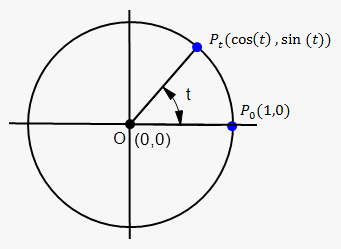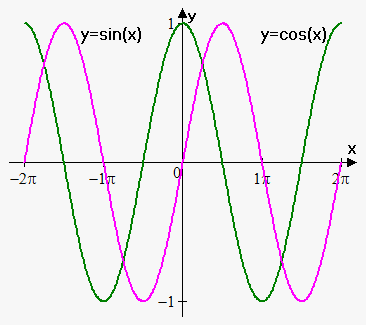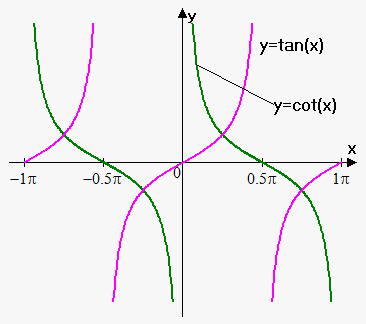Trigonometric Functions
 Consider unit circle centered at origin and point $$${P}_{{0}}{\left({1},{0}\right)}$$$. If we begin to rotate point $$${P}_{{0}}$$$ around origin on angle $$${t}$$$ then we will obtain point $$${P}_{{t}}$$$.
Consider unit circle centered at origin and point $$${P}_{{0}}{\left({1},{0}\right)}$$$. If we begin to rotate point $$${P}_{{0}}$$$ around origin on angle $$${t}$$$ then we will obtain point $$${P}_{{t}}$$$.
x-coordinate of this point is called cosine of number $$${t}$$$ and denoted by $$${\cos{{\left({t}\right)}}}$$$, y-coordinate of this point is called sine of number $$${t}$$$ and denoted by $$${\sin{{\left({t}\right)}}}$$$.
Tangent of number $$${t}$$$ is ratio of sine and cosine: $$${\tan{{\left({t}\right)}}}=\frac{{{\sin{{\left({t}\right)}}}}}{{{\cos{{\left({t}\right)}}}}}$$$.
Cotangent of number $$${t}$$$ is ratio of cosine and sine: $$${\cot{{\left({t}\right)}}}=\frac{{{\cos{{\left({t}\right)}}}}}{{{\sin{{\left({t}\right)}}}}}$$$.
Secant of number $$${t}$$$ is $$${\sec{{\left({t}\right)}}}=\frac{{1}}{{{\cos{{\left({t}\right)}}}}}$$$.
Cosecant of number $$${t}$$$ is $$${\csc{{\left({t}\right)}}}=\frac{{1}}{{{\sin{{\left({t}\right)}}}}}$$$.
When we talk about trigonometric functions we can use both radian and degree measure of angle $$${t}$$$, but in calculus we almost always use radian measure (unless other stated).
To convert radian measure to degree and vice versa following formulas are used:
$$${1}\ {r}{a}{d}=\frac{{{{180}}^{{0}}}}{\pi}\approx{{57}}^{{0}}$$$ and $$${{1}}^{{0}}=\frac{\pi}{{{{180}}^{{0}}}}\ {r}{a}{d}\approx{0.017}\ {r}{a}{d}$$$.
So, $$$\pi$$$ is $$${{180}}^{{0}}$$$, $$${2}\pi$$$ is $$${{360}}^{{0}}$$$, $$$\frac{\pi}{{2}}$$$ is $$${{90}}^{{0}}$$$ etc.
Domain of cosine and sine is $$${\left(-\infty,\infty\right)}$$$, their range is $$${\left[-{1},{1}\right]}$$$.
These functions are periodic with main period $$${2}\pi$$$, i.e. $$${\sin{{\left({x}+{2}\pi\right)}}}={\sin{{\left({x}\right)}}}$$$ and $$${\cos{{\left({x}+{2}\pi\right)}}}={\cos{{\left({x}\right)}}}$$$ for all $$${x}$$$.
Domain of tangent function is all $$${x}$$$ except those $$${x}$$$ where $$${\cos{{\left({x}\right)}}}={0}$$$.
Range of tangent function is $$${\left(-\infty,\infty\right)}$$$.
Tangent is periodic function with period $$$\pi$$$: $$${\tan{{\left({x}+\pi\right)}}}={\tan{{\left({x}\right)}}}$$$ for all $$${x}$$$.
 Domain of cotangent function is all $$${x}$$$ except those $$${x}$$$ where $$${\sin{{\left({x}\right)}}}={0}$$$.
Domain of cotangent function is all $$${x}$$$ except those $$${x}$$$ where $$${\sin{{\left({x}\right)}}}={0}$$$.
Range of cotangent function is $$${\left(-\infty,\infty\right)}$$$. Cotangent is periodic function with period $$$\pi$$$: $$${\cot{{\left({x}+\pi\right)}}}={\cot{{\left({x}\right)}}}$$$ for all $$${x}$$$.
Following formulas hold for trigonometric functions. They will be used in further notes:
- $$${{\cos}}^{{2}}{\left({x}\right)}+{{\sin}}^{{2}}{\left({x}\right)}={1}$$$ for all $$${x}$$$.
- $$${1}+{{\tan}}^{{2}}{\left({x}\right)}={{\sec}}^{{2}}{\left({x}\right)}$$$ for all $$${x}$$$.
- $$${1}+{{\cot}}^{{2}}{\left({x}\right)}={{\csc}}^{{2}}{\left({x}\right)}$$$ for all $$${x}$$$.
- $$${\sin{{\left({x}\pm{y}\right)}}}={\sin{{\left({x}\right)}}}{\cos{{\left({y}\right)}}}\pm{\cos{{\left({x}\right)}}}{\sin{{\left({y}\right)}}}$$$ for all $$${x},{y}$$$.
- $$${\cos{{\left({x}+{y}\right)}}}={\cos{{\left({x}\right)}}}{\cos{{\left({y}\right)}}}-{\sin{{\left({x}\right)}}}{\sin{{\left({y}\right)}}}$$$ for all $$${x},{y}$$$.
- $$${\cos{{\left({x}-{y}\right)}}}={\cos{{\left({x}\right)}}}{\cos{{\left({y}\right)}}}+{\sin{{\left({x}\right)}}}{\sin{{\left({y}\right)}}}$$$ for all $$${x},{y}$$$.
- $$${\tan{{\left({x}+{y}\right)}}}=\frac{{{\tan{{\left({x}\right)}}}+{\tan{{\left({y}\right)}}}}}{{{1}-{\tan{{\left({x}\right)}}}{\tan{{\left({y}\right)}}}}}$$$ for all $$${x},{y}$$$.
- $$${\tan{{\left({x}-{y}\right)}}}=\frac{{{\tan{{\left({x}\right)}}}-{\tan{{\left({y}\right)}}}}}{{{1}+{\tan{{\left({x}\right)}}}{\tan{{\left({y}\right)}}}}}$$$ for all $$${x},{y}$$$.
Trigonometric functions, because of periodicity, are widely used for modeling repetitive events: motion of pendulum, vibrating string, sound waves etc.
